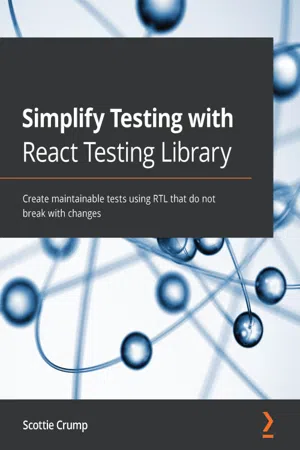
- 246 pages
- English
- ePUB (mobile friendly)
- Available on iOS & Android
Simplify Testing with React Testing Library
About this book
A fast-paced, practical guide to helping you leverage React Testing Library to test the DOM output of componentsKey Features• Get to grips with React Testing Library and create tests that don't break with changes in implementation• Learn how to put RTL into practice by implementing it in real-world scenarios• Test apps to be more accessible and ensure your tests will work with actual DOM nodesBook DescriptionReact Testing Library (RTL) is a lightweight and easy-to-use tool for testing the document object model (DOM) output of components. This book will show you how to use this modern, user-friendly tool to test React components, reducing the risk that your application will not work as expected in production. The book demonstrates code snippets that will allow you to implement RTL easily, helping you to understand the guiding principles of the DOM Testing Library to write tests from the perspective of the user. You'll explore the advantages of testing components from the perspective of individuals who will actually use your components, and use test-driven development (TDD) to drive the process of writing tests. As you advance, you'll discover how to add RTL to React projects, test components using the Context API, and also learn how to write user interface (UI) end-to-end tests using the popular Cypress library. Throughout this book, you'll work with practical examples and useful explanations to be able to confidently create tests that don't break when changes are made. By the end of this React book, you will have learned all you need to be able to test React components confidently.What you will learn• Explore React Testing Library and its use cases• Get to grips with the RTL ecosystem• Apply jest-dom to enhance your tests using RTL• Gain the confidence you need to create tests that don't break with changes using RTL• Integrate Cucumber and Cypress into your test suite• Use TDD to drive the process of writing tests• Apply your existing React knowledge for using RTLWho this book is forThis book is for software engineers, quality engineers and React developers who want to learn about modern practices used for testing React components using the latest testing tool, RTL. Basic knowledge of React development is required to get the most out of this book.
Frequently asked questions
- Essential is ideal for learners and professionals who enjoy exploring a wide range of subjects. Access the Essential Library with 800,000+ trusted titles and best-sellers across business, personal growth, and the humanities. Includes unlimited reading time and Standard Read Aloud voice.
- Complete: Perfect for advanced learners and researchers needing full, unrestricted access. Unlock 1.4M+ books across hundreds of subjects, including academic and specialized titles. The Complete Plan also includes advanced features like Premium Read Aloud and Research Assistant.
Please note we cannot support devices running on iOS 13 and Android 7 or earlier. Learn more about using the app.
Information
Chapter 1: Exploring React Testing Library
- Learning about the DOM Testing Library
- Understanding the role of Jest in testing React applications
- Learning about the advantages of using jest-dom to test React applications with Jest
- Understanding the disadvantages of implementation detail-focused testing
Technical requirements
Introducing the DOM Testing Library
What is the DOM Testing Library?
Table of contents
- Simplify Testing with React Testing Library
- Contributors
- Preface
- Chapter 1: Exploring React Testing Library
- Chapter 2: Working with React Testing Library
- Chapter 3: Testing Complex Components with React Testing Library
- Chapter 4: Integration Testing and Third-Party Libraries in Your Application
- Chapter 5: Refactoring Legacy Applications with React Testing Library
- Chapter 6: Implementing Additional Tools and Plugins for Testing
- Chapter 7: End-to-End UI Testing with Cypress
- Answers
- Other Books You May Enjoy